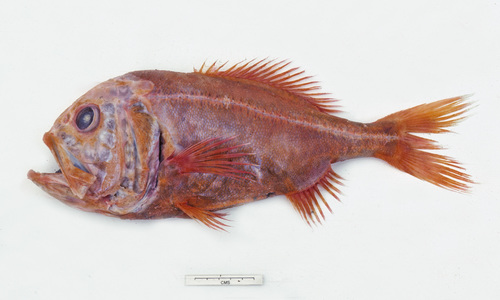
Orange roughy
The Atlantic Bluefin Tuna (Thunnus thynnus) is a magnificent and highly migratory species of tuna found in the Atlantic Ocean. Renowned for its size, speed, and commercial value, it plays a crucial role in the marine ecosystem. This species is a top predator, facing increasing pressure from overfishing, making it a focus of conservation efforts.
20 150 years
Lifespan
75 cm
Length
Vulnerable
Conservation Status
5 km/h
Swimming speed
Carnivorous
Diet
Local Migration
Migration
Appearance Overview
The Atlantic Bluefin Tuna is renowned for its large, streamlined body, built for speed and endurance.
Coloration
Dark metallic blue above, shading to silvery white below
Fins
Two dorsal fins, the first depressible into a groove; short pectoral fins
Body Shape
Torpedo-shaped, designed for efficient swimming
Length
Up to 13 feet (4 meters), commonly around 6.5 feet (2 meters)
Weight
Up to 2,000 lbs (907 kg), commonly around 550 lbs (250 kg)
Diet
Carnivorous, feeding on a variety of fish, squid, eels, and crustaceans.
Feeding Behavior
Highly active predator, using speed and agility to hunt. They may hunt cooperatively, herding prey.
Social Behavior
Forms schools, sometimes segregated by size. Known for long migrations across the Atlantic.
Commercial Relevance
Extremely high value, particularly in sushi and sashimi markets, driving significant fishing pressure.
Conservation measures
Subject to international fishing quotas and management plans, marine protected areas, and ongoing research.
Status
Endangered (IUCN)
Threats
Overfishing (historically and ongoing), bycatch in fisheries targeting other species, climate change affecting prey distribution.
Habitat Distribution
Depth Range
0-3,300 feet (0-1,000 meters), most common in surface to 656 feet (200 meters)
Geographic Range
Primarily the Atlantic Ocean, including the Mediterranean Sea. Two main populations: Western Atlantic and Eastern Atlantic/Mediterranean.
Preferred Environment
Temperate and subtropical waters; pelagic (open ocean), but also ventures closer to shore.
Reproduction and Life Cycle
Breeding Habits
Spawns in warm waters; two main spawning grounds: the Gulf of Mexico (western population) and the Mediterranean Sea (eastern population). Spawning occurs in spring and summer.
Development Stages
Eggs hatch into larvae, which are planktonic. Juveniles grow rapidly, eventually reaching maturity. Growth rates differ between the western and eastern populations.
Fecundity
Highly fecund; a large female can produce up to 30 million eggs per spawning season.
Maturity Age
Matures at around 4-5 years in the western Atlantic and 3-4 years for eastern population.
Faqs about Orange roughy
Can you eat Atlantic Bluefin Tuna?
Yes, but due to their endangered status, consumption should be avoided to support conservation efforts.
How long do Bluefin Tuna live?
They can live up to 40 years, though this is becoming rarer due to fishing pressure.
How fast can Bluefin Tuna swim?
They are among the fastest fish, capable of bursts of speed up to 43 mph (70 km/h).
What are the predators of the Bluefin Tuna?
They have few natural predators besides killer whales, and some sharks. Humans are their primary threat.
Are bluefin tuna warm-blooded?
Bluefin tuna are warm-blooded. This helps them to survive in cold water and swim at high speeds.
Copyright @ Nature Style Limited. All Rights Reserved.
 English
English